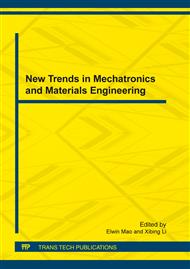p.424
p.429
p.433
p.438
p.442
p.446
p.451
p.458
p.463
Analysis of Key Stresses of Coated Tool in High Speed Cutting
Abstract:
The wear resistance of coated tool can be predicted widely by experiments and theoretical analysis. In the paper, an unique method is adopted to analyze influence of high speed on key stresses of the coated tool .First, through the cutting process simulation with different high cutting speeds, contact stress, shear stress and temperature distribution of the surface of the coated tool can be obtained when the cutting process is steady. Then the stresses and temperature are applied to the coated tool to analyze the key stresses in the tool. The result shows the potential failure of coated tool can be predicted by Finite element analysis correctly. Crack between coating and substrate may occur at the same position with different cutting speeds.
Info:
Periodical:
Pages:
442-445
Citation:
Online since:
January 2012
Authors:
Keywords:
Price:
Сopyright:
© 2012 Trans Tech Publications Ltd. All Rights Reserved
Share:
Citation:


